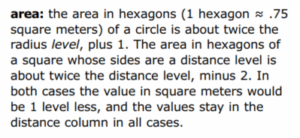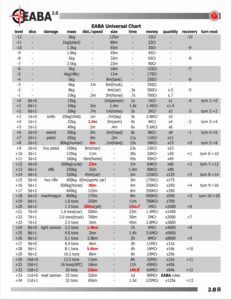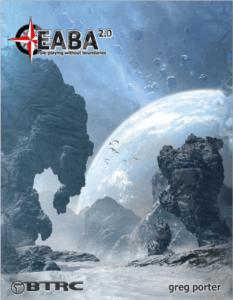EABA (End All Be All) 2e is a generic roleplaying system with a core rulebook and a collection of sourcebooks designed by Greg Porter and published by his company BTRC (Blacksburg Tactical Research Centre). The first edition was released in 2003, the second – which is what we discuss in this episode – in 2012. Greg was kind enough to send us copies of the PDF to review, and we are grateful for his generosity.
“It’s a pretty good name for an RPG: ‘be-all’, you could be anyone; ‘end-all’, you’re going to kill a bunch of guys.” – James
This episode is brought to you by the generosity of Christian Bickle who backed Ludonarrative Dissidents’ Season 3 Kickstarter at the level that allowed him to select a game for us to review. EABA was his choice, and it’s a good one. Huge thanks go to him for his support of the podcast.
SHOW NOTES
These are the notes for this episode, a chance for us to pick up the threads, fill in the blanks, throw up some links, and correct the occasional errors that we didn’t have time to deal with in the episode itself.
Greg Porter is a games industry veteran who’s been active since the mid-1980s. He founded the Blacksburg Tactical Research Center (note: not an actual tactical research centre) while at college and published his first RPG, Timelords, in 1987. As well as releasing his own games, Greg has also done work for other publishers and systems including the Imperium Games edition of Traveller. In the early 2000s BTRC broke ground by becoming the first publisher to release games exclusively as PDFs. Known for a distinctive horned headband that he been wearing at games conventions long before tiefling-style prosthetics became a thing, he’s excellent company. Notable releases:
- Timelords
- Guns! Guns! Guns! (aka 3G3), a weapon-design supplement for almost any RPG
- The Macho Women with Guns trilogy
- Slag! space-combat game
- CORPS
- End All Be All
The PDF format was developed by Adobe in the early 1990s, mostly as a wrapper around their PostScript printer language (1982) to create documents that could be output to any screen or platform without the need for extra files such as fonts or graphics. The spec was released for free in 1993, and at first was mostly adopted by publishers as a way to send their work to book-printers digitally. Javascript, integrated with Acrobat 3.0, allows PDFs to include executables like EABA‘s built-in dice-roller, but also potentially malicious code, which is why you shouldn’t open PDFs emailed to you from unknown sources. The maximum size of a PDF is a square 15,000,000 inches on each side, about 145,161 km2, slightly larger than Greece and Montenegro put together.
Interactive Fantasy was a quasi-academic journal released by James’s company Hogshead Publishing in the mid-1990s, an attempt to bring some rigour to discussions about the theory and practice of narrative game design. Contributors included Greg Porter, Greg Stafford, Greg Costikyan, Jonathan Tweet, Robin Laws and many more. All four issues can now be downloaded for free.
The quote that EABA‘s title comes from – “Be all and end all” – comes from Macbeth’s soliloquy at the start of Act 1, Scene 7, the one that begins “If it were done when ’tis done, then t’were well it were done quickly.”
Generic RPG systems have been around since 1980, when Chaosium included the Basic Role-Playing 16-page booklet (designed by Steve Perrin) in the Runequest 2e boxed set. Typically they’re a system of mechanics designed to be used with multiple different settings. GURPS, Steve Jackson Games’ Generic Universal Role Playing System (1986, now on its fourth edition) was the best known until Wizards of the Coast open-sourced the D&D 3e mechanics under the Open Gaming Licence in 2000. Hero, Fate, Savage Worlds and others have their followers, though one could argue that Powered By The Apocalypse has pretty much won this round. Other designers regard any game’s attempts to be the only RPG system you’ll ever need as a pointless attempt to lock players into a single ruleset and reduce all genre and narrative nuance to sludge.
Phoenix Command is the aforementioned RPG of ridiculously detailed modern combat, revolving around too many lookup tables. Now out of print.
 Speaking of over-complexity, this is the paragraph on page 14 of the rulebook where James started skimming EABA‘s mechanics.
Speaking of over-complexity, this is the paragraph on page 14 of the rulebook where James started skimming EABA‘s mechanics.
And speaking of maths, Greg references the use of the Golden Ratio in classical art. The Golden Ratio (1:1.618) can be plotted to create an off-centre spiral (the Golden Spiral, similar but not identical to a Fibonacci Spiral), which when overlaid on many masterpieces of world art – the theory goes – coincides with key spots in their composition, and circles in to their main focal point. The Golden Ratio is not to be confused with √2 (1:1.414), which is the ratio of the sides of the A-series of paper sizes.
Lancer is a tactical RPG of battling giant robots, which we field-stripped back in season 1 episode 3.
Savage Worlds is a generic RPG system of cinematic action, and we gave that a thorough going-over (along with extensive show notes) in season 3 episode 3.
The Tsolyani banquet I mentioned was at a games convention in Cambridge in the early 1990s and organised by friend-of-podcast Mike Cule. Not only was it arranged according to the laws of Tsolyani etiquette (the Tsolyani Empire is the dominant civilisation on Tekumel, the setting of Empire of the Petal Throne), with guests seated on daises of various heights depending on their social status, we were all served a selection of weird and wonderful delicacies. Apparently Mike went into one of Cambridge’s premier delicatessens and said, “Give me fifty quid of the weirdest foods you have. No dairy.” This was the early 90s, when £50 went a lot further on weird food than it would today. The banquet remains one of the most memorable RPG experiences I’ve ever had.
Unity and Unreal are two of the dominant video-game engines, third-party systems used by studios to create new games. The closest RPG parallel is the D&D Open Gaming Licence (see below): you bring the content, you use their underlying systems. However with the OGL you don’t pay a royalty to the engine owner for its use.
 This is the EABA Universal Chart described in the podcast, a full-page lookup table at the heart of the game’s mechanics. Click to examine it in all its detail. Such things have their place in gaming, and James believes that place is the early 1980s.
This is the EABA Universal Chart described in the podcast, a full-page lookup table at the heart of the game’s mechanics. Click to examine it in all its detail. Such things have their place in gaming, and James believes that place is the early 1980s.
The GNS triangle (Gamist–Narrativist–Simulationist) is something we discussed and shownoted in the Savage Worlds episode. It’s a Forge-era way of breaking down types of RPGs (and player intent and agency within games) in a way that all RPG designers ought to at least be aware of. The Wikipedia entry on it is pretty good.
A ‘fantasy heartbreaker’ is, in classic terms, an RPG produced and unwisely published by an inexperienced designer who is convinced their game is going to change the world because it has twelve different character classes and a critical-hits system, and their clerics can use swords. In the 90s James used to walk around the trade hall at Gen Con with Jonathan Tweet, asking new publishers about their games and what made them exciting. Roughly 60% would immediately launch into a description of the game’s mechanics. Mechanics don’t sell RPGs.
‘That scene from The Matrix‘ is the lobby sequence, scene #150, where Neo and Trinity shoot their way into the building where Morpheus is being held, to a soundtrack by the Propellerheads. Until the John Wick series it was the apotheosis of balletic combat in Hollywood movies.
The escalation die in 13th Age was discussed at some length by us in season 1 episode 11, at 26:35 so I’ll direct you straight to it instead of repeating ourselves here.
Characters in the Ghostbusters RPG (1986) can choose one of five ‘personal goals’: Sex, Soulless Science, Fame, Serving Humanity or Money, and that’s the whole of the human race summed up in a game mechanic right there.
The 36 Dramatic Situations was written by Frenchman Georges Polti in 1895, based on his examination of classical literature. It is not 36 different plots, but different incidents that can be jigsawed together to create all the elements of a satisfactory story. A few examples include supplication; deliverance; crime pursued by vengeance; pursuit; and disaster: It was not the first of this sort of thing – that would be The Golden Bough from 1890 – but is among the most influential of a genre that includes books from the basic (The Seven Basic Plots) up to the ridiculous (Plotto).
The Open Game Licence, referred to above, was WotC’s ground-breaking initiative of making the mechanics and system of D&D 3rd edition (2000) freely available to anyone who wanted to use them, via the licence itself and the System Reference Document. This cemented D&D‘s position at the top of the RPG tree and created a glut of products in the early 2000s, much of it unsellable rubbish that gummed up industry cashflow and sent many publishers, distributors and retailers to the wall.
Reign is Greg Stolze’s critically lauded game of being senior management in a fantasy realm.
Terraforming Mars, while an excellent board game, is never going to happen whatever Elon Musk wants you to think. The planet’s gravity is too light, its magnetic field is too weak, its soil is too toxic, its sunlight is too faint, and getting there is a pain. For further disappointing information on the subject we refer you to Kelly and Zach Weinersmith’s 2023 book A City On Mars.
Paul Bourne, whose full-page art is a standout feature of EABA, is also responsible for art, layout and physical production on several of the UK’s most aesthetically spectacular RPGs of this century, including a|state, Cold City, Hot War, Beowulf and The Silver Road.
Thank you for listening! The hosts of this episode were Ross Payton, Greg Stolze and James Wallis, with audio editing by Ross and show notes by James. We hope you enjoyed it. If anything in this podcast or these notes has spurred your interest then we invite you to come and chat about it on our friendly Discord.
If you click on any of the above links to DriveThruRPG and buy something, Ludonarrative Dissidents will receive a small affiliate fee. You will not be charged more, and the game’s publisher will not receive less, it’s a win-win-win. Thank you for supporting the podcast this way.
